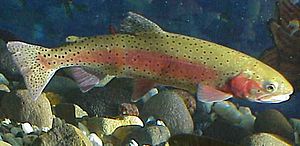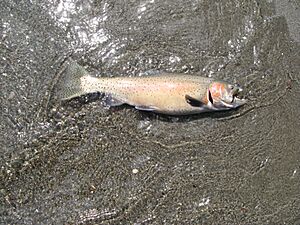Lahontan cutthroat trout facts for kids
Quick facts for kids Lahontan cutthroat trout |
|
|---|---|
 |
|
| O. clarkii henshawi, stream form | |
| Conservation status | |
| Scientific classification |
|
| Kingdom: | Animalia |
| Phylum: | Chordata |
| Class: | Actinopterygii |
| Order: | Salmoniformes |
| Family: | Salmonidae |
| Genus: | Oncorhynchus |
| Species: | |
| Subspecies: |
O. c. henshawi
|
| Trinomial name | |
| Oncorhynchus clarkii henshawi (Gill and Jordan, 1878)
|
|
The Lahontan cutthroat trout (Oncorhynchus clarkii henshawi) is a special type of cutthroat trout. It's the biggest kind of cutthroat trout! This fish is also the official state fish of Nevada. Sadly, it's one of three cutthroat trout types that are considered threatened by the government, meaning they need protection.
Contents
About the Lahontan Cutthroat Trout

These trout originally lived in rivers that flowed into an ancient lake called Lake Lahontan. This huge lake existed during the ice ages. When the ice age ended about 7,000 years ago, the lake shrank. It left behind smaller lakes like Pyramid Lake and Walker Lake. Lake Tahoe is also connected to these waters.
Lahontan cutthroat trout grew very large. They could be up to 1 meter (39 inches) long! They were predators, meaning they hunted other fish. In the bigger lakes, they ate fish like chub suckers. But in smaller streams, they had to adapt and eat smaller fish and insects. Some scientists even think the trout in the upper Humboldt River might be a slightly different type.
The biggest cutthroat trout ever caught was a Lahontan cutthroat. It was caught in Pyramid Lake and weighed an amazing 41 pounds (18.6 kg)! There are even old stories and photos of even bigger fish from this lake.
Their Story with People
The Lahontan cutthroat trout was very important to the Paiute tribe. These fish, along with another fish called cui-ui, were a main part of their diet. They also traded these fish with other tribes.
In 1844, explorers John C. Frémont and Kit Carson saw these huge trout. They called the Truckee River the 'Salmon Trout River' because of the many large Lahontan cutthroat trout swimming up from Pyramid Lake to lay their eggs.
However, when American settlers moved into the Great Basin, the number of these fish dropped sharply. Between 1860 and 1920, people caught huge amounts of trout. They shipped them to towns and mining camps across the West. Some estimates say over 1 million pounds (453,592 kg) were caught each year!
Dams built on rivers caused big problems. A dam in Mason Valley blocked the fish from swimming up to lay eggs from Walker Lake. In 1905, the Derby Dam on the Truckee River also stopped fish from reaching Pyramid Lake. A special ladder for fish washed away, and water was taken for farms at the wrong times. This left spawning fish stranded and their eggs dried out. By 1943, the Lahontan cutthroat trout were gone from Pyramid Lake.
By 1930, the trout in Lake Tahoe also disappeared. This happened because new fish like rainbow trout were brought in. These new fish competed for food and spread diseases. They also mixed with the native trout, creating "cutbows" instead of pure Lahontan cutthroat trout.
Trout living upstream also faced problems. Poor grazing practices and too much water taken for irrigation hurt their homes. Mixing with other types of fish and being eaten by non-native fish also caused their numbers to drop. Even though these trout can live in lakes or streams, they must lay their eggs in streams.
Saving the Lahontan Cutthroat Trout
Today, Lahontan cutthroat trout live in only a small part of where they used to be found. The biggest challenge to their recovery is other fish that eat them. These include brook trout in rivers and lake trout in lakes. Also, the mixing of Lahontan cutthroat trout with non-native rainbow trout continues to be a threat.
In the Truckee River system, only Independence Lake has always had its native Lahontan cutthroat population. Their numbers were very low, but they have recently increased after five years of removing brook trout.
Pyramid and Walker Lakes have been restocked with trout from Summit Lake (Nevada) and Lake Heenan. Fish hatcheries help keep these populations going. Sadly, the fish from Summit Lake don't live as long or grow as big as the original trout from Pyramid Lake.
However, in the 1970s, a wonderful discovery was made! Fish believed to be from the original Pyramid Lake trout were found in a small stream near Pilot Peak in Utah. These fish were a perfect genetic match to the original strain! This "Pilot Peak strain" is now very important for programs that reintroduce and plant these trout. The U.S. Fish and Wildlife Service runs these programs.
To help these trout survive, it's important to protect different types of habitats. They need clean gravel for laying eggs. Young fish need slow-moving areas along the sides of rivers. Bigger adult fish need deeper pools, like those created by beavers.
The Lahontan cutthroat trout was first listed as an endangered species in 1970. In 1975, its status was changed to threatened species, and this was confirmed again in 2008.
Even though Lahontan cutthroat trout might not survive long in Lake Tahoe, the Nevada Department of Wildlife (NDOW) started planting them there in 2011. The goal is for people to be able to catch Lake Tahoe's native trout again. The California state record for this fish was caught in Lake Tahoe in 1911. It weighed an impressive 31 pounds, 8 ounces!
Because these trout can live in water that is too alkaline for other trout, they are stocked in some alkaline lakes outside their native area. These include Lake Lenore, Grimes Lake, and Omak Lake in central Washington, and Mann Lake in Oregon.
Images for kids




